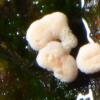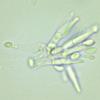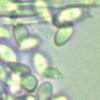
19-08-2014 16:18
Steve ClementsPossible Geocladium luteolumHi,This was found on a

18-08-2014 18:42
 Mafalda Freire Fernando
Mafalda Freire Fernando
Hi, Does anyone have this one?Entomogenous fungi f

14-08-2014 20:14
 Miguel Ángel Ribes
Miguel Ángel Ribes
Good eveningThis small 800-1000 µm yellow-orange,

17-08-2014 16:56
Salvador TelloHola a todos. Hace unos días cogí un hongo que
Possible Geocladium luteolum
Steve Clements,
19-08-2014 16:18
Hi,
This was found on an old beech log, with Nectria coccinea. The pale off-white pulvinate (up to imm diameter) sporodochia? looked yellowish under LED and more pinkish under halogen light. Conidia were abundant and looked agglutinated, hyaline, up to 6 x 3 um. The only structures I could see were Penicillium-like phialides. Ellis and Ellis pointed to Geocladium luteolum as a possible ID. Does this make sense?
Steve
Paul Cannon,
19-08-2014 16:30
Re : Possible Geocladium luteolum
I think this is the anamorph of Nectria (now Neonectria) coccinea. It has a Cylindrocarpon anamorph which produces microconidia like your collection, as well as long curved Fusarium-like macroconidia.
Best wishes
Paul
Best wishes
Paul
Steve Clements,
19-08-2014 20:39
Re : Possible Geocladium luteolum
Thanks very much Paul, that makes sense, with its intimate relations with the N coccinea. It's another one for the list, all be it a conidial form!
Steve
Steve








